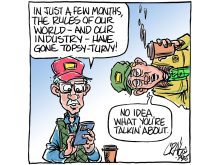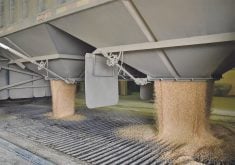CANADA’S World Trade Organization challenge of American country-of-origin labelling legislation is idling at the curb, waiting to be driven.
That is more or less the way federal agriculture minister Gerry Ritz described the status of the challenge Canada filed last year and then put on hold after early January changes partially addressed Canadian concerns.
The challenge remained stalled after U.S. president Barack Obama announced a review of COOL. His secretary of agriculture, Tom Vilsack, last week announced COOL would go forward as proposed, including the changes Canada favoured in early January.
Read Also

Crop profitability looks grim in new outlook
With grain prices depressed, returns per acre are looking dismal on all the major crops with some significantly worse than others.
However, Vilsack also asked the U.S. industry to voluntarily add even more information to labels, a request that has received lukewarm response. Vilsack is a strong supporter of COOL and has hinted at more stringent rules in the offing.
Compliance could prevent U.S. meatpackers and processors from buying Canadian livestock and meat to avoid the additional cost of segregation and labelling.
Canada’s WTO challenge should indeed be revved up and ready to roll, because COOL is slated to go into effect March 16. It has the potential to irreparably damage the Canadian livestock industry by drastically reducing exports of live animals and meat to the United States.
COOL has been pilloried by the Canadian meat industry but also by its American equivalent. Meat agencies, processors and cattle organizations decry the additional expense it will incur through purchasing, segregating and labelling.
Meat sectors on both sides of the border also believe COOL will lower prices producers receive for their animals, raise the cost of meat and further reduce steadily shrinking per capita consumption.
Here in Canada, Ritz says cattle and hog exporters have not yet seen damage from the threat of COOL, notwithstanding American packers’ drastic reduction of feeder hog purchases in the latter half of 2008 – a reduction everyone attributed to pending COOL rules.
Agriculture Canada figures show slaughter and feeder hog exports to the U.S. are down 66 and 32 percent respectively from this time last year.
On the slaughter cattle side, exports are down 19 percent, while feeder cattle and calves are down 30 percent from last year.
Pending COOL legislation may not be the entire reason, but it is certainly part of it.
Canadian cattle and hog groups are busy compiling information on exports and the impact of COOL for use in either Canada-U.S. negotiations or a renewed WTO challenge. It would behoove every producer in Canada to gather data as well, because preservation of the industry might depend upon it.
The Canadian Cattlemen’s Association says it expects the government to do everything possible to avoid damage to the domestic industry that may be inflicted by COOL. Failing that, the CCA says it expects the government to move quickly to resolve trade disputes.
It would be better to resolve the unfair trade issues presented by COOL through talks rather than an international trade challenge. But if that doesn’t work, Ritz must put the WTO challenge into drive and step on the gas.
Bruce Dyck, Terry Fries, Barb Glen, D’Arce McMillan and Ken Zacharias collaborate in the writing of Western Producer editorials.














